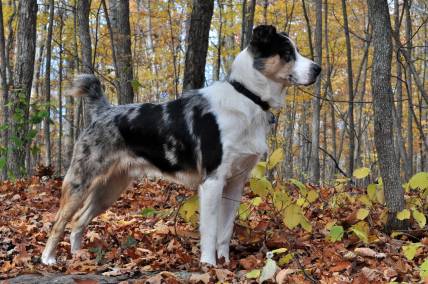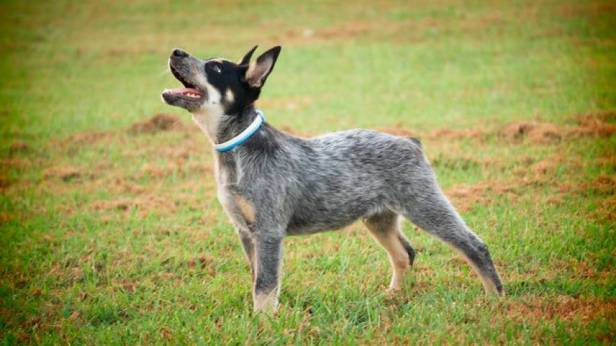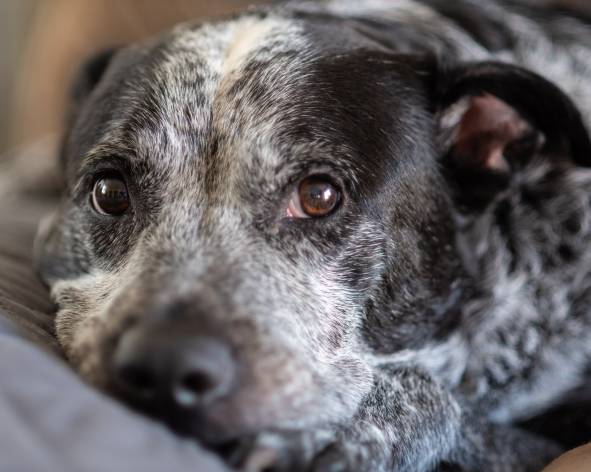Connect with a verified veterinarian in minutes. Licensed vets are available 24/7 to answer your questions. No need to worry about your furry family member.
Many pet parents fall in love with certain dog breeds, such as the Labrador Retriever and the Blue Heeler. But what would happen if you could combine both breeds into one amazing dog?
Well, it’s possible and is being done! If you’re looking to adopt a dog and love both the Lab and the Blue Heeler, why not consider a Labraheeler?
We’ve put together the information you need to know about these dogs before deciding to adopt one. Let’s get started!
What is a Labraheeler?
The Labraheeler is a hybrid dog breed that’s the result of crossing a purebred Labrador Retriever with a purebred Blue Heeler! These are relatively new dogs, and there’s not much information about this hybrid mix. But we can learn more about the dogs by taking a look at their purebred parents!
Labrador Retrievers, also referred to as Labs originally came from an island off the coast of Newfoundland. The dogs were first developed in the 1700s to help fishermen retrieve fish. However, over time, the dogs were used for hunting and retrieving waterfowl.
The dogs are athletic and muscular and have coats that are easy to take care of. The dogs are also full of energy. Because of their intelligence, energy, and loving natures, the dogs are used as working dogs, including as therapy dogs.
Labs are known for their warm, loving personalities and high level of intelligence. The breed is popular in the US and is the number one registered dog on the AKC’s list! If you’ve been around a Lab, then you can understand how the dogs come in at the number one position!
The Labraheeler’s other parent is the Blue Heeler (also called the Australian Cattle Dog)! These dogs have a very interesting history. They were originally bred in Australia to be working dogs, mainly used to herd sheep and other cattle. However, the most interesting fact is that the English dogs first brought to Australia were not able to cope with the harsh climate. So, breeders started to breed the English dogs with Australia’s wild canines, the Dingo!
The result is a high-energy working dog. These dogs have a ton of energy and want a job to do. Blue Heelers can quickly become bored when they don’t have something to do. This can lead to destructive and other unwanted behaviors, which may include everything from digging, chewing, and more!
Blue Heelers are devoted to their families and usually choose one pet parent to bond with. These dogs are also sometimes called “Velcro dogs” because they attach themselves to their chosen person, following them around most of the day.
In addition, these dogs have a strong prey drive. This means the dogs are not good around cats and other small animals unless the dog has been properly trained and socialized from a young age.
These dogs are friendly, though they are wary of strangers. In addition, the dogs are quite durable and can handle all types of terrain, temperature variations, and more!
With parents like this, how could a Labraheeler be anything but an excellent dog?
Labraheelers usually stand between 41 to 65 inches and weigh between 18 to 25 lbs. They have a life expectancy of 12 to 15 years.
Labraheeler Appearance
Labraheelers are hybrid dogs that randomly receive genes from both their parents. That means puppies from a single litter may vary greatly from one another. Each puppy is a unique little being that has received different genes from their Lab and Blue Heeler parents. For this reason, there’s no breed standard established for the Labraheeler. The dogs can vary greatly, but they’re still beautiful!
Both parent dogs are well-muscled, have athletic bodies, and are medium-sized dogs. The Labraheeler usually has a broad forehead with well-set eyes. The dog’s ears may stand up (like the Blue Heeler’s) or flop to the sides of his face (like the Lab). The dogs can have striking eye colors, including blue, green, or brown. The dog’s face is usually intelligent and calm.
When it comes to their fur, the Labraheeler usually has short, straight fur that comes in a wide range of colors, including yellow, blue, white, brindle, and black. Most of these dogs usually have more than one color and may even have some spots and markings across their bodies.

Review symptoms, medications & behavior to keep your pets healthy with a Vet Online in just minutes.
Ask a Vet Live NowLabraheeler Temperament
The Labraheeler has been described as a “real dog’s dog.” They love to run, play, and get in the mud! And this hybrid dog makes a great family companion, as long as the owners have time to spend with their canine companion.
The dogs have a good nature and bond with their families. And they love to show their affection! What could be better than that? What’s more, the dogs will protect their families. This trait makes Labraheelers amazing guard dogs.
Are Labraheelers Good with Kids & Other Pets?
In addition, the dogs usually do well with new people and other dogs if they dogs have been properly socialized from a young age. Labraheelers may be wary of a stranger at first, but their friendly nature soon shows itself!
The dogs are good with kids; however, they should never be left alone with children (the same applies to all dog breeds). It’s possible for a Labraheeler to become very excited and play too rough with the kids.
When it comes to smaller pets, the dogs should always be supervised closely. Here, again, it’s imperative the dog be socialized from a young age. If not, they may see small animals as something to hunt.
Are Labraheelers Trainable?
Labraheelers are eager to please, just like their purebred parents. They respond best to positive reinforcement training methods. So, be sure to have plenty of praise and treats on hand to show your fur baby he’s doing a great job!
Labraheeler Exercise Requirements
The Labraheeler is a mix of the Lab and the Blue Heeler, both of which are high-energy dogs! So, you can expect the Labraheeler to be a very active dog. They need something to do with all that energy! The dogs enjoy hiking, jogging, swimming, and have a job to do.
For these reasons, the Labraheeler needs at least 60 minutes of exercise a day. One more note—these dogs don’t do well in a small home or apartment. They are best suited to living in a rural area where they can run free and burn off calories all day long.
Summing It Up
As you can see, Labraheelers are wonderful dogs that love their families and can get along well with kids and other pets. However, the dogs must be properly socialized. They make great dogs for active families that can spend time with the dogs and ensure they have work to do.
If you choose to adopt a Labraheeler, we’re pretty sure you’ll have a wonderful, loving, fun companion for years to come!
Connect with a verified veterinarian in minutes. Licensed vets are available 24/7 to answer your questions. No need to worry about your furry family member.

Julie
Julie is a graduate of the University of North Carolina, Wilmington, where she studied Animal science. Though contrary to the opinion of her parents she was meant to study pharmacy, but she was in love with animals especially cats. Julie currently works in an animal research institute (NGO) in California and loves spending quality time with her little cat. She has the passion for making research about animals, how they survive, their way of life among others and publishes it. Julie is also happily married with two kids.
Review symptoms, medications & behavior to keep your pets healthy with a Vet Online in just minutes.
Ask a Vet Live Now




